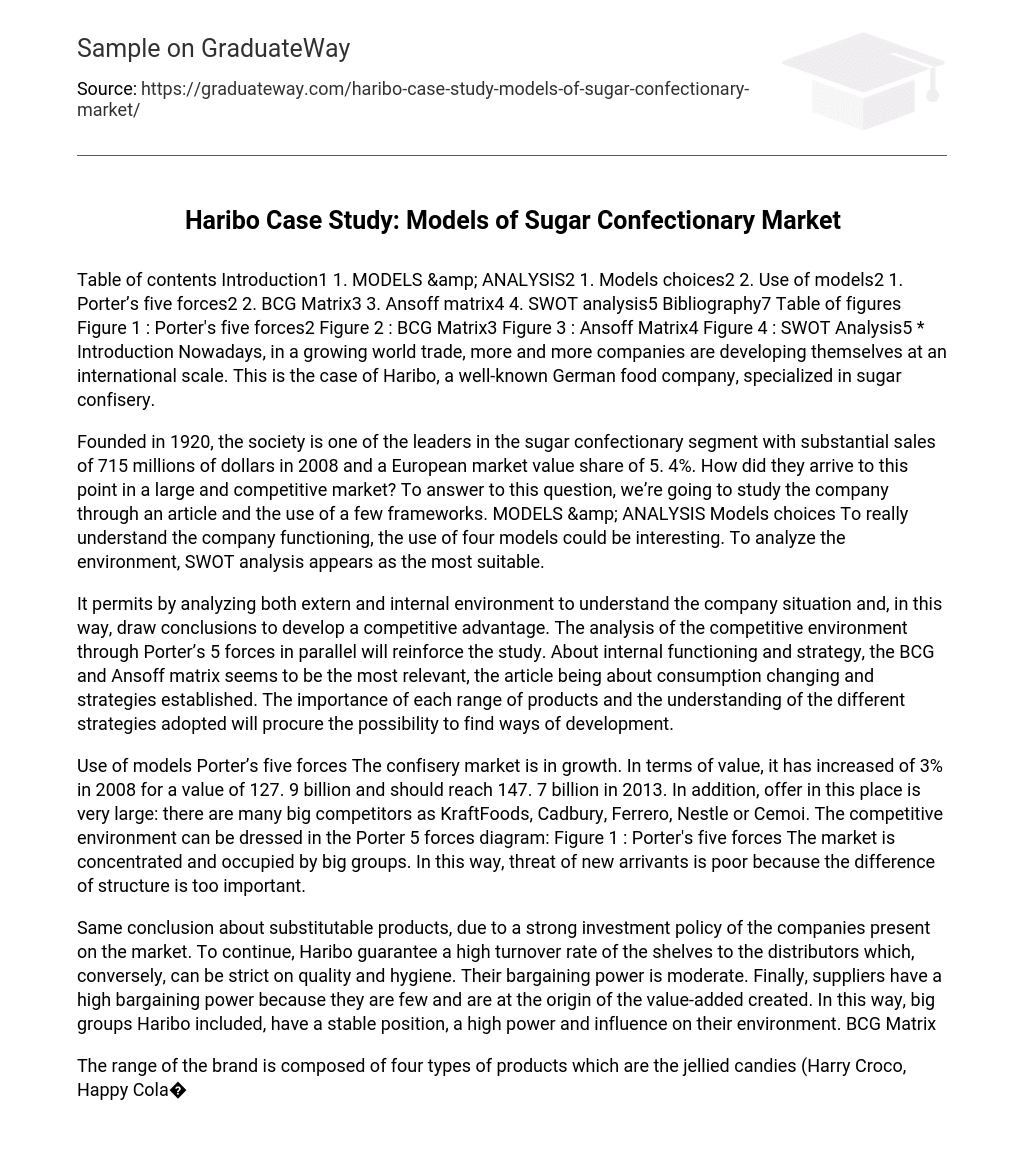Nowadays, many companies are expanding globally due to the increasing world trade. One such company is Haribo, a famous German food company that specializes in sugar confectionery.
Established in 1920, this society has emerged as a prominent player in the sugar confectionary industry. With impressive sales amounting to 715 millions of dollars in 2008 and a European market value share of 5.4%, the society has successfully carved a niche for itself in the highly competitive market. To understand their journey and achievements, we will delve into an article and explore a few frameworks.
When it comes to comprehending the operations of a company, utilizing four models can be beneficial. In terms of examining the surroundings, the SWOT analysis is deemed the most appropriate as it allows for an assessment of both the external and internal environment. This, in turn, facilitates an understanding of the company’s situation and enables the development of a competitive advantage. Additionally, conducting a study of the competitive environment using Porter’s 5 forces in conjunction with the SWOT analysis will further enhance the analysis.
The most relevant matrices for understanding internal functioning and strategy are the BCG and Ansoff matrices. The article focuses on changing consumption patterns and the strategies that have been established. It emphasizes the importance of each product range and understanding the various strategies adopted, which will enable the identification of development opportunities.
The confisery market is experiencing growth, with a 3% increase in value in 2008, reaching 127.9 billion. It is projected to reach 147.7 billion in 2013. The market is highly competitive, with major players such as KraftFoods, Cadbury, Ferrero, Nestle, and Cemoi. Due to the concentration of the market and dominance of these big groups, the threat of new entrants is low due to the significant structural difference.
Haribo guarantees a high turnover rate of the shelves to distributors, which can be strict on quality and hygiene due to the strong investment policy of companies on the market. The bargaining power of the distributors is moderate. Suppliers, on the other hand, have a high bargaining power as they are few and responsible for the value-added created. This gives big groups like Haribo a stable position with high power and influence in their environment.
Tenders liquorices, which are regarded as Cash Cows, are products that have low growth but high profitability. Haribo must continue to defend its position against competitors in order to generate essential funds for developing stars. Hard liquorices, on the other hand, have good growth potential but a small market share, resulting in limited profits. As a result, Haribo should invest in this range to maximize profits or consider discontinuing it. Furthermore, the company has various products that are positioned in either a depressed market or a highly competitive market. These products should be eliminated to reduce costs.
Additionally, Haribo implements a differentiation strategy by providing customers with a wide range of options that surpass what currently exists, continually introducing new products. The company’s success stems from an ongoing commitment to innovation and delivering high-quality goods. Nevertheless, contemporary consumption patterns are evolving.
Concerns about health and new regulations on food advertising have prompted the growing trend of people preferring healthy food and becoming more conscious about their diets. To tap into this market shift, Haribo has embraced a new strategy by expanding its product offerings and targeting a wider customer base. The company introduced a new range of products with reduced sugar content to address the health-conscious trend. At the same time, Haribo tapped into the nostalgia trend to attract more adults to consume their products. They play on the notion that this new range could remind adults of the sweets they enjoyed in their youth, thus encouraging increased consumption among this demographic.
Haribo has achieved its current status by catering to two segments: adults, with a focus on health and well-being, and children, with their appealing tastes and colors. However, the company now places more emphasis on targeting adults. Conducting a SWOT analysis allows for a comprehensive understanding of Haribo’s situation by considering all the external and internal factors affecting the company.
The article discusses the various strong points of Haribo, both on an internal and external level. Internally, Haribo’s size, brand image, and effective differentiation strategy are highlighted as major strengths. However, externally, the increasing importance of health food among customers and strict regulations on food advertising pose challenges for Haribo’s sweetened products. Despite these challenges, Haribo must leverage its strengths to capitalize on opportunities. In conclusion, the article identifies four tools as particularly compelling within the context of the “Haribo Case Study.”
The SWOT analysis has been selected for multiple reasons. Firstly, it can encompass various frameworks and provide an overall perspective of the company’s situation. Secondly, certain tools, such as the Diamond model of the International Product cycle, were not applicable in this specific case. Additionally, the BCG and Ansoff matrix directly relate to the article’s focus on new products and development considerations.





